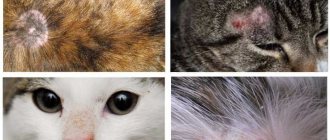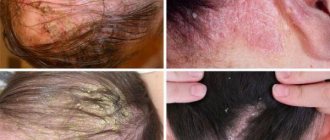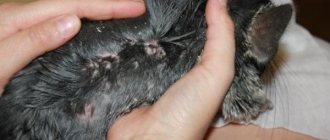Itching in a dog is an unpleasant phenomenon, accompanied by severe scratching. It is not an independent disease, but only acts as a symptom, warning about the danger. If your pet constantly scratches its body, then without timely help it will tear off its skin. Numerous injuries will lead to secondary infection and aggravate the existing problem.
How does itching appear in dogs?
It's quite easy to suspect something is wrong. The dog constantly itches and chews itself in a certain area or throughout the body. Due to unpleasant sensations, she sleeps poorly and refuses games and favorite treats. Appetite decreases, which quickly affects weight. The hair gradually falls out until some areas become completely bald. The skin becomes red and inflamed.
The probable cause of itching in a dog can be determined by its location. Active scratching of the ears indicates a high probability of otodectosis. If your pet rubs all parts of its body against furniture and rolls around on the floor, it may suffer from a skin disease or an allergic reaction. Regardless of the cause, treatment is carried out only after diagnosis in a veterinary clinic.
Apple vinegar
Of course, apple cider vinegar is a delicious ingredient in homemade salad dressings, but did you know that it can also be used as a powerful antibacterial and antifungal agent?
Simply mix a mixture of 50 percent apple cider vinegar and 50 percent water in a clean spray bottle, then spray the solution onto your dog's itchy spots.
If your dog's paws are irritated, you can use the mixture for a nice, relaxing paw soak for up to five minutes.
Warning
Apple cider vinegar should never be used on raw skin or open wounds; it can be very painful for your dog and worsen the symptoms.
Diagnosis and identification of the cause
Using medications before diagnosis can distort test results. Veterinarians recommend avoiding self-medication and seeking help immediately after an alarming symptom appears.
After a visual examination and history taking, the veterinarian performs the following diagnostic tests:
- stool and urine analysis;
- clinical and blood biochemistry;
- skin scraping, as well as scraping of secretions from the affected areas;
- allergy tests;
- Ultrasound and X-ray.
If there are symptoms of a fungal infection and negative results of basic tests, additional tests may be required. The most popular diagnostic method for this disease is the Wood's lamp.
Prevention
Prevention of dog diseases is a series of simple procedures that the owner should carry out regularly:
- Visit the veterinarian for a general examination at least 2 times a year.
- It is mandatory to have all necessary vaccinations from a very early age.
- It is necessary to regularly groom your dog by bathing and brushing it.
- From time to time it is necessary to independently examine the dog for problem areas on its skin.
- Monitor your pet's behavior and mood changes.
Parasitoses
Most often, itching in a dog occurs when infected with external parasites. This is due to lack of timely processing.
Fleas
Flea infestations cause an allergic reaction to the parasites' saliva. It contains a foreign protein that is rejected by the body of an infected animal. If there is a severe infestation of blood-sucking insects, you can notice them yourself. They look like small black or brown grains.
Despite the species classification based on the final host, fleas quickly adapt and can feed on the blood of any animal, including humans. The most dangerous species is the rat. These parasites are more likely than others to carry dangerous infections. A bitten dog can become infected with rickettsiosis, helminthiasis, endocarditis and other diseases.
Ticks
It is possible to find out why a dog itches if it does not have fleas by observing the accompanying symptoms. Tick-borne infestations are characterized by yellowing and severe peeling of the skin, as well as the formation of purulent inflammations. With otodectosis, dark brown discharge forms in the ears, and the sick pet constantly shakes its head.
Infection with subcutaneous mites is fraught with problems with the lymph nodes, kidneys, stomach, spleen and liver. Due to numerous wounds, the risk of death from sepsis increases. Once a secondary infection occurs, the chance of recovery is only 50%.
Like fleas, ticks carry infections. An infected person may suffer from hepatozoonosis, ehrlichiosis, bartonellosis or piroplasmosis.
lice eaters
Lice eaters are the closest relatives of lice, resembling white grains of dandruff and characterized by a quadrangular head shape. They feed on particles of fur and skin, causing severe itching in the dog. Most often, the symptom of infection occurs at the base of the tail, ears, belly or thighs. The affected skin becomes rough and thickened. The condition of the coat is deteriorating. Bald patches form.
Puppies can become infected from a sick mother. In addition to the listed symptoms, the presence of lice in young animals can lead to developmental delays. Also, these parasites often carry helminth eggs, which is especially dangerous for pets under 1 year of age.
Colloidal oat baths
This age-old remedy isn't just an old wives' tale—a colloidal oatmeal bath can seriously soothe your dog's itchy skin by reducing inflammation and flushing out allergens trapped in the fur.
Whether you buy pre-made colloidal oatmeal (made by grinding oats into a fine powder and boiling to release the colloid) or grind your own plain, sugar-free oatmeal into a powder, the anti-inflammatory properties of colloidal oatmeal can help relieve redness, swelling, and itching, as well as Cool your dog's hot, uncomfortable skin.
What's more, oatmeal is completely non-toxic, so you don't have to worry about your dog licking it.
Skin diseases
Owners often do not understand what to do if the dog is itchy all the time, but it does not have fleas or other parasites. The fact is that parasitosis is only one of the possible causes. The symptom may also occur due to allergies, exposure to high or low temperatures, fungal or bacterial infections, or malfunction of the exocrine glands.
Allergy
Increased sensitivity to certain irritants causes the dog to experience itching, peeling of the paw pads and redness of the interdigital area. Watery discharge appears from the eyes and nose, and swelling and rash appear on the skin. Diarrhea and excessive sweating may occur, which can be easily detected by a damp sleeping area.
Allergic reactions in four-legged pets are more severe than in humans. They get worse with age, so it is recommended to stop attacks immediately after they occur.
Irritation from cold or heat
Overheating and frostbite injure the skin, so the animal constantly licks itself. This leads to the development of acral dermatitis - compulsive licking, leading to the formation of dense ulcerations and tissue death. This disease causes severe intoxication and is difficult to treat. Heat can also cause itchy pyoderma and even cancer.
Fungus (lichen)
The most dangerous fungal infection is ringworm. It is caused by fungi of the genus Microsporum. A sick dog constantly scratches its hind legs, neck and head. As the disease progresses, the fungi spread to the back and eventually affect the entire body. Infected skin develops circular redness, dry scabs and bald areas with well-defined borders.
Bacterial infection
Skin diseases are often caused by bacterial infections. The most common causes of pathology are streptococci and staphylococci, which cause pyoderma. This disease is accompanied by the appearance of erosive and ulcerative formations, purulent papules and skin inflammation. The patient's body becomes covered with dandruff and begins to emit a pungent smell of rot. The dog itches and bites the itchy areas, becoming weak and lethargic.
The hips, anus and base of the tail are primarily affected. The affected areas become covered with a rash, and their temperature rises. When touching the inflamed areas, the pet experiences a feeling of pain. Without treatment, inflammation spreads to neighboring areas, which can lead to necrosis and sepsis.
Hyperfunction of the sebaceous glands
Hyperplasia of the sebaceous glands, or sebaceous tail, occurs due to a disruption of the secretory function. The exact cause of this pathology has not been identified, but veterinarians identify several predisposing factors:
- lack of regular skin and coat care;
- the presence of other skin diseases or allergies;
- being kept in poor conditions and having a poor diet;
- sudden decrease in immunity.
Itchy sensations appear near the anus and at the base of the tail. Blackheads, redness, lumps and dandruff appear in these places. The fur begins to stick together and fall out.
Secondary infection
I would like to pay special attention to this complication. Any itching will cause the dog to scratch furiously. Our task is to prevent this as quickly and effectively as possible, since the complication is always the same - a secondary bacterial or fungal infection of the skin. What kind of infection is this mysterious? This is a conditionally pathogenic microflora that always lives in the environment (including on the dog’s skin). When scratching, the protective surface of the dermis is destroyed, and all bacteria and fungi immediately strive to settle and multiply on this fertile soil. And this makes the situation even worse. Wounds (and these are real wounds), in addition to continuing to itch, also develop a crust, foul-smelling discharge, or even pus. Of course, this requires emergency care and comprehensive treatment.
Other reasons
The remaining causes are associated with psychological and internal disorders, as well as inflammation of the anal glands - small sacs with secretions that allow animals to distinguish each other by smell. With frequent inflammations, four-legged patients have to regularly visit the veterinarian for preventative cleaning of the glands. You can also learn this on your own.
Past stress
Constant scratching may be due to severe stress. It occurs due to experiences associated with moving, changing owners, having new family members, traveling by car, going to the veterinary clinic or grooming. If the animal’s condition returns to normal after a couple of hours or a day, then the stress is considered short-term and does not require medical intervention. In other cases, the resulting disorder is considered chronic. Without treatment it will only get worse.
Symptoms of mental disorders may include:
- mood swings;
- prolonged licking until the formation of bald patches;
- refusal to execute commands;
- excessive intrusiveness or desire for privacy;
- gnawing fur and biting the body;
- slight trembling and drooling;
- running in circles accompanied by barking or squealing;
- the emergence of interest in inedible objects;
- digging holes contrary to the owner's prohibitions.
Feeling changes in its body, the pet tries to get support and help from a person. To do this, he can spoil your favorite things and defecate directly on the floor. If your pet is well-bred, then such sudden changes are a serious reason to contact a veterinarian.
Diseases of internal organs
Itching in a dog is one of the symptoms of diabetes, endometritis, liver and kidney failure. Ultrasound and x-rays are used to identify pathologies of internal organs. These studies help determine the exact area and extent of its damage.
Inflammation of the anal glands
The anal glands are located just behind the entrance to the anus. The secretion they contain allows them to mark territory during bowel movements. When these pouches become inflamed, the dog rolls on its butt, bites its tail and licks the anus.
The cause of the inflammatory process is denser stool or clogged glands. This interferes with the natural release of secretions and leads to stagnation.
The dog is constantly itching and gnawing at itself, if there are no fleas - what does this mean?
Increased itching, causing the pet to constantly scratch itself, chew, lick itself, sleep disturbances, appetite - all these symptoms indicate that something is seriously bothering the dog.
But if the symptoms are not caused by the animal having fleas, then what is the reason for their appearance?
This behavior may be caused by:
- parasitic diseases caused by various kinds of ectoparasites;
- fungal diseases;
- hormonal disorders;
- allergic reactions;
- stress.
Note! The exact cause of itching can only be determined by visiting a veterinarian.
Treating the root cause
The main goal of treatment is to eliminate the root cause. Symptomatic therapy is carried out in combination. Depending on the diagnosis, the following treatment options are offered:
- Parasitoses
. The four-legged patient is prescribed insecticidal drugs (Spregal, Anandin, Frontline) that destroy the causative agent of the disease.
- Allergy
. Allergic reactions are suppressed with antihistamines (Suprastin, Tavegil, Diphenhydramine). Food allergies are blocked with a therapeutic diet that excludes allergenic foods, or with therapeutic hypoallergenic food.
- Irritation from cold or heat
. Secondary infections are suppressed with antibiotic therapy and glucocorticosteroids. Damaged areas are restored with anti-inflammatory ointments with a healing effect.
- Fungal and bacterial infections
. Eliminated with antibiotics and antifungal drugs. An animal with lichen is isolated in a separate room to prevent infection of other family members.
- Hyperfunction of the sebaceous glands
. It is treated with antibiotic therapy and treatment of inflamed areas with antiseptics.
- Stress
. The animal is protected from irritating factors or gradually accustomed to them. The veterinarian may also recommend taking sedatives (Fitex, Stop-Stress) or collars with pheromones that reduce anxiety.
- Diseases of internal organs
. Treatment focuses on repairing the damaged organ.
- Inflammation of the anal glands
. In case of severe inflammation, the veterinarian prescribes a course of antibiotics and suppositories. In other cases, the stagnant secretion is released by manual stimulation.
If the dog itches, then bathe it more often, relieving inflammation with the help of special shampoos. For faster healing, the affected areas are lubricated with linseed oil. For the same purpose, it is recommended to use decoctions of oak bark, birch leaves, oat grains and strawberry roots.
Aloe vera
If you've ever had a sunburn, you know that all-natural aloe vera can save you. Aloe vera is not only a powerful healing agent, but it also reduces redness and draws away unpleasant heat from the skin.
You can apply aloe vera directly to the affected areas of your dog. Most grocery stores and pharmacies sell 100% natural aloe vera, or you can harvest it from an aloe vera plant if you have one at home.
Warning
Be sure to use aloe vera gel that does not contain alcohol, otherwise you risk burning your dog's skin and worsening his symptoms.
What should owners do about this problem?
First of all, it is necessary to exclude the presence of fleas on the pet’s bedding. If they are not on the litter or on the dog, then the next step will be to determine the cause of the appearance of such symptoms.
If constant scratching is accompanied by redness of the skin under the fur or alopecia, then you should think about whether your pet has health problems.
As a rule, if the cause is identified in a timely manner and treatment is prescribed in a timely manner, the disease can be cured quite easily.
How to treat an animal?
The veterinarian, as a rule, prescribes complex drug treatment in accordance with his diagnosis.
To eliminate the symptoms and manifestations of the disease, treatment should be carried out using:
- drops and ointments aimed at eliminating itching and irritation;
- ointments and creams for external treatment of lesions;
- antihistamines;
- antiparasitic shampoos.
Let's celebrate! If an allergy is detected in the dog, the treatment will be supplemented by normalizing nutrition and taking vitamins. Don’t forget about prevention, because as we know, this is the best treatment.











